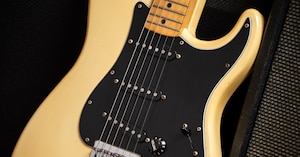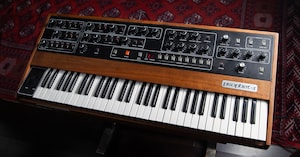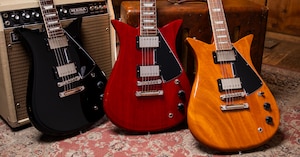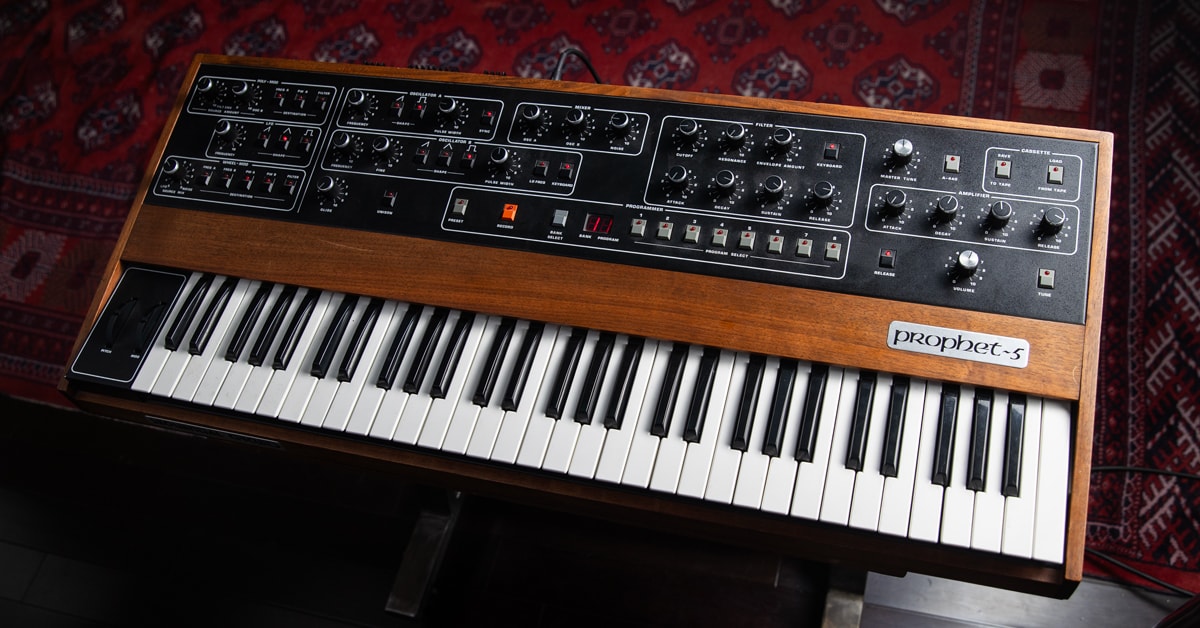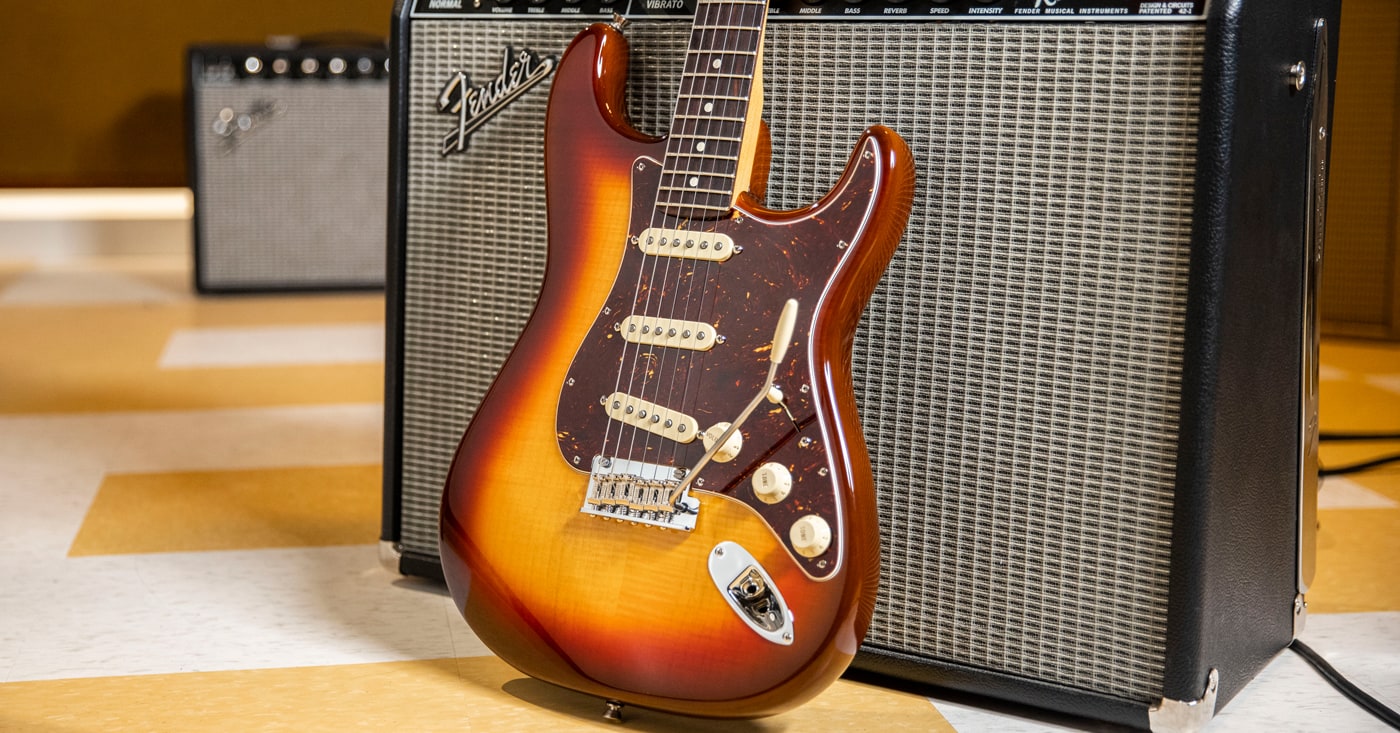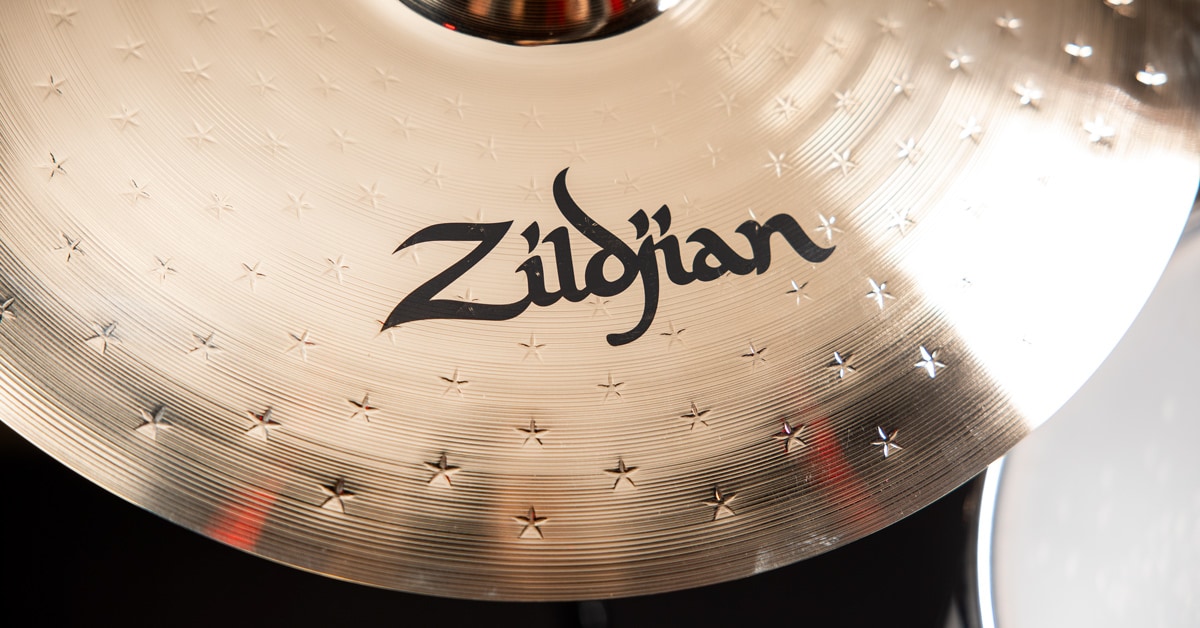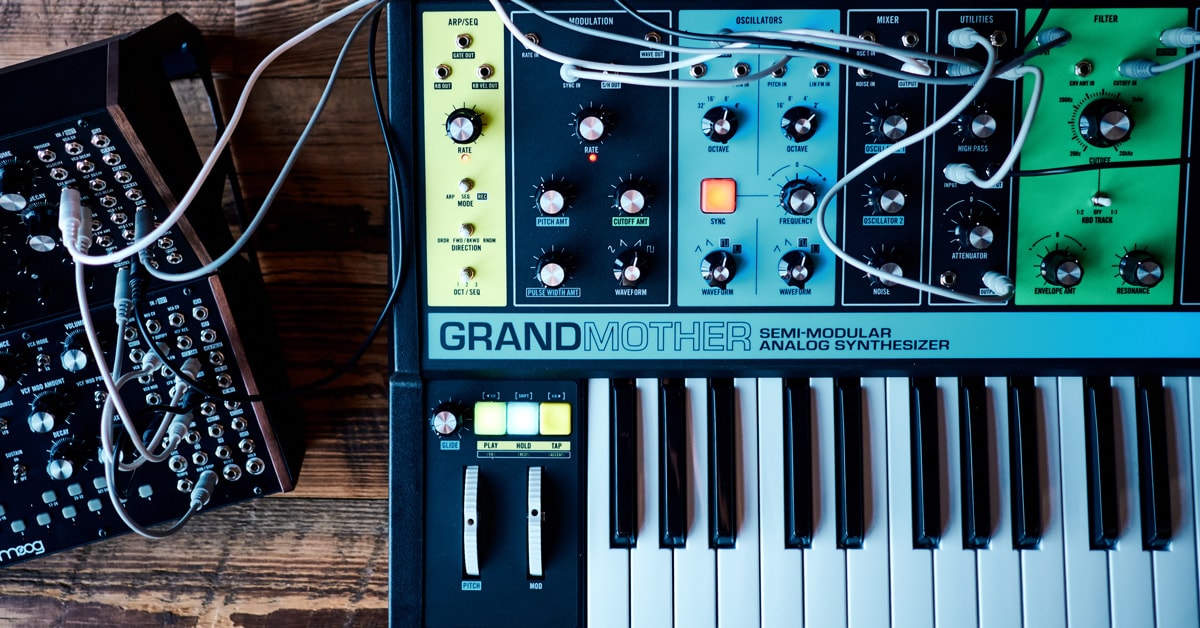Synthesizers have been an integral part of music since they first appeared on popular recordings in the 1960s. In this guide, we're going to give you the info you'll need to buy the best synth for you and your music. In the process, we'll be taking a quick look at some of the most popular and groundbreaking synths on the market.
We'll be covering the full spectrum of modern synthesizers. These range from ultra-compact but powerful hybrid units, like the KORG microKORG and Arturia MicroFreak, to sophisticated workstation units such as the Yamaha MONTAGE M Series, KORG NAUTILUS and Roland FANTOM. We'll also examine the recent resurgence in modular analog synthesizers, like the Moog Mother-32, and then touch on the category of virtual software instruments that can recreate vintage analog synths and offer groundbreaking new synthesis models.
This guide should also help answer some basic questions about the different types of synths. We'll talk about what they do without drowning you in technical jargon, though you may have to dip your toes in the water. By the time you're finished reading this, you should know the basic difference between analog, digital and hybrid, as well as the emergence of analog modeling synths. We'll also talk about monophonic vs. polyphonic, the difference between models designed for the studio and the stage, and what makes a keyboard a "workstation." Ready? Okay, let's start brewing up some sounds.
Table of Contents
What's All This Going to Cost Me?
I Just Want a Synth Now
What Synths Will Be Best For Me?
What Sounds Do I Want?
Monophonic vs. Polyphonic
Analog, Digital, Hybrid, Modeling—What's the Difference?
Analog Synthesis
Digital Synthesis
Hybrid Synthesis
Synth or Workstation?
A Quick Word About Software Synthesizers
Shopping for Synths
Auditioning Synths
Getting Your Best Synth Deals
What's All This Going to Cost Me?
The quick answer to that question is, probably less than you think. While early synths could be tens of thousands of dollars (and that's in 1960s dollars), today you can get started for under $150 with a synth that will fit in your pocket. KORG's Nu:Tekt NTS-1 is a powerful, fun DIY synth that you assemble yourself, with no need for a soldering iron! Once assembled, its versatile digital oscillator offers up a wide range of sonic building blocks to choose from prior to passing through its multimode filter, envelope generator, LFO and effects. An easy-to-use arpeggiator and MIDI connectivity open up a world of sound design possibilities.
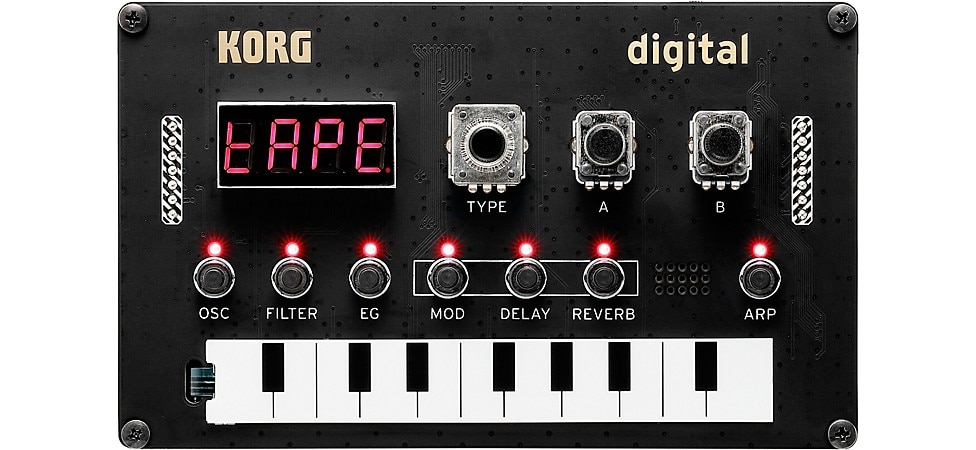
Pictured: KORG Nu:Tekt NTS-1 Digital DIY Synthesizer
At the other end of the spectrum, you can lay down some serious cash for systems like the Moog One. Moog is a legendary name in synthesis and the company remains firmly committed to founder Robert Moog's mission to create unparalleled instruments. The Moog One is a 16-voice analog synthesizer with digital controls and effects. This combination gives it classic, fat analog sounds with an ease of control that is more suited to the modern player.
I Just Want a Synth Now
For those of you who want to get started right away, we're going to start off with a couple of quick recommendations for easily affordable compact synths. These choices sound great, have plenty of flexibility, a solid set of basic sounds and are easy to use. As an added bonus, both of these choices feature vocoders—the ability to speak or sing into a mic and have that signal make the synthesizer sounds "speak."
The first quick pick choice on our list is the KORG microKORG XL+. The first generation of microKORG was a huge hit and succeeding editions added new sounds and features that make it even more appealing. The latest version offers analog modeling of vintage synths, FM synthesis, a selection of sampled vintage keyboards like organs, electric pianos and a nice range of what KORG calls "Tape" instruments (think Mellotron). In addition, the original microKORG was one of the first compact keyboards to offer the vocoder feature referred to above. With a responsive 37-key mini-keyboard, battery power and KORG's Kaoss effects, it's a synth powerhouse you can take anywhere.
Our second quick-pick synth is another powerhouse in a compact package. The Roland JD-Xi also has multiple synth types—analog, digital, sample-based and, a big plus for musicians who love the classic drum and percussion sounds of hip-hop and house music, iconic sounds from Roland’s TR-808 and TR-909 Rhythm Programmers. The JD-Xi also features a 4-track sequencer, as well as the vocoder mentioned earlier. This section features an auto-pitch function for the popular "robot-voice" effect, in addition to the standard vocoder features. Roland's velocity-sensitive 37-key mini-keyboard gives you plenty of range to get creative.
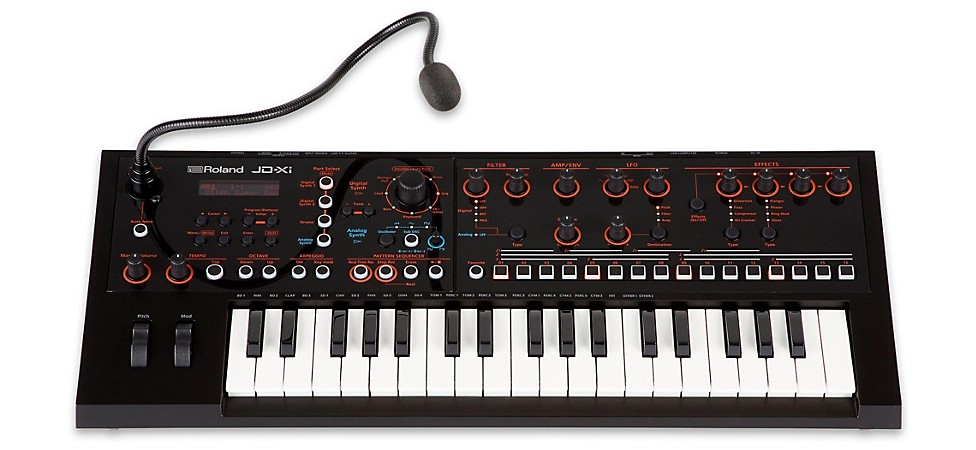
Pictured: Roland JD-Xi Synthesizer/Vocoder
What Synths Will Be Best for Me?
Both the synths mentioned in the section above are great places to get started. In the longer run, though, you're probably going to end up with more than one synth, and what will suit you best is going to depend on your primary use—on stage or in the studio.
Though there's certainly a fair amount of crossover between the two uses, there are some basic differences between synthesizers designed for stage use and for studio use. Generally speaking, a stage system will be more portable and cover more ground, sonically, while having more of a preset-based operating system. Systems for studio use will tend to be more tweakable and more specialized. Of course, there are exceptions, like the gargantuan Moog Modular system the late Keith Emerson used to tour with.
At the very highest level is the design of what's known as the keybed. This term is used to refer to the number of keys and what type of key action a keyboard has. The number of keys can range from 25 keys to 88 keys for ranges of just over two octaves to just over seven octaves. The common values are 25, 37, 49, 61, 73 and 88 keys, with each jump signifying an extra octave of range. If you're going to be playing fully orchestrated parts that require two hands to play, the more keys the better. On the other hand, if you'll be using your synth mostly for leads and pads, you probably won't need as wide a range, as almost every small synth has an easy way to shift octaves on the fly.
After number of keys, the action type is of concern. The simplest is what's called "synth action." This keybed is completely unweighted, with little to no resistance to finger pressure. They are usually velocity sensitive, meaning the harder and faster you press the key, the louder the note will sound, but it's harder to control dynamics for players who are more used to something like a piano.
The next class of keybed is called "semi-weighted action." These have some form of resistance, generally a spring of some sort, to provide a more piano-like feel, and are easier to play at varying dynamic levels.
The final class are the "weighted-action" keybeds. There are some variations here, ranging from simply adding weights to the keys for resistance, to keybeds that use a pivot action similar to a piano, to "graded-hammer-action" ones that use a mechanical action with varying resistance to give the most piano-like feel possible. If you're a piano player, these are the keypads that will feel the most like the instrument you've been used to playing.
In addition, there are some size variations. None of these sizes are standardized and will vary from one manufacturer to the next. Mini-keys, generally found on portable keyboards and what are called "tabletop" synths, can vary from button-type keys to keys about the size of a child's toy piano. So-called "slimline" keys are in the middle range, a little longer and wider than minis. The full-size keys are, well, full-size. Which one is better? That's strictly a matter of personal taste and what works best for the way you use the instrument. Generally speaking, mini keys keep your fingers almost touching each other and might be a little clunky for chordal work but minimize stretching for lead work. Slimline keys will have your fingers slightly separated, and full-size keys will have your fingers spread as if playing a standard piano or organ.
There is also a class of synth that may or may not have a keyboard. The modular synthesizer harkens back to the early, large synthesizers that were built from separate modules for oscillators, filters of various sorts, low-frequency oscillators (LFOs) and the rest of the bits that made up an analog system. These systems are very expandable and offer a variety of ways to both be controlled and to control other systems. From CV, or control voltage, to modern MIDI implementations, the modular systems are flexible, expandable and, for the most part, enable you to put together a system that crosses brand borders, tying together the modules that do what you need, regardless of who made them. The Moog Modular was the first, and their Moog Mother ecosystem is seriously popular among modular fans. Other companies like Cre8audio, Roland, KORG and Sequential make either tabletop units or modules that plug into a Eurorack chassis (Eurorack is a standard for size, and a chassis will house and power multiple modules). Modular and semi-modular setups are adored by players who love experimentation and the nitty-gritty of creating new sounds from scratch.
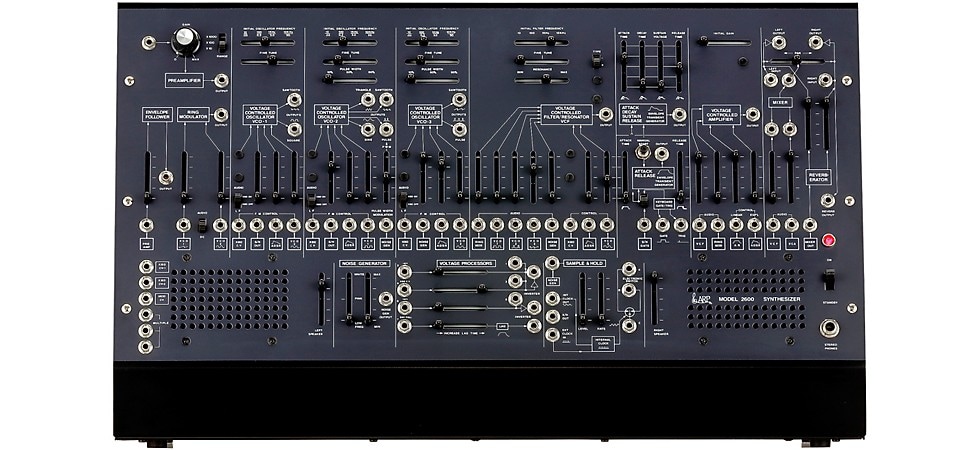
Pictured: ARP 2600 M Synthesizer
What Sounds Do I Want?
Even though Shakespeare proclaimed that "A rose is a rose …," there's enough variation in the synth world that he couldn't have said, "a synth is a synth." Different flavors of synthesis—different "synth engines," or ways for producing the final sound—will give varying textures and complexity of sound. So, one question that you need to ask yourself is, "What is it that I want to sound like?" With so many different options available, let's look at some of the basic differences.
Monophonic vs. Polyphonic
While the terms should be fairly self-explanatory ("mono"= one, "poly" = many, "phone" = voice), there are specific uses and advantages to both types of synth.
The mono synth may play only one note at a time, but when it comes to bass lines, leads and sequenced ostinato lines, they really can't be beat. Generally small and light, they are exceptionally easy to add to your stage rig. In the studio, their approach to pure synthesis makes them amazing sound-design tools. The KORG MS-20 mini, an exacting replica of KORG's 1978 MS-20, can create incredibly fat bass lines and lead sounds with astounding complexity. The MS-20 mini can also be used as a processor for external sound sources, adding whole new levels of flexibility. The Moog Grandmother, which was first unveiled at Moogfest 2018, brings Bob Moog's seminal synth designs into the modern era with a semi-modular design that easily interfaces with almost every Moog product, as well as most Eurorack modular systems.

Pictured: KORG MS-20 mini Synthesizer
Polyphonic systems can range from four-voice to 128-voice or more in larger workstation units. Poly synths make rich pads possible, along with two-handed playing for chordal accompaniment and complex harmony. They tend to be a littler larger than monophonic units, but there are some that are still extremely compact. The Moog Matriarch is a four-voice synth that uses the same semi-modular concept as the Moog Grandmother mentioned above. Introduced at Moogfest 2019, Matriarch is also easily interfaced with analog modular units from Moog and others, with the added attraction of being able to stack all the oscillators. This turns the Matriarch into a "super-mono" synth that's capable of complex single-voice sounds that pack an incredible punch. The four-voice KORG Minilogue XD offers this ability as well, and adds built-in digital effects and an extra digital oscillator for sounds with a texture that steps beyond the pure analog.
Analog, Digital, Hybrid, Modeling—What's the Difference?
We've been throwing around the terms analog and digital as types of synthesis, and it's time we talk about those a little more. As we promised at the beginning, we're not going to go too far into the weeds here (that's another whole article or three), but just provide a little foundation.
Analog Synthesis
Simply put, analog synthesis uses analog circuits—oscillators; high-pass, low-pass and band-pass filter networks; amplifiers; even electro-mechanical circuits (technically, the Hammond organ is, at heart, a synthesizer)—to create and modify sounds. We won't go deeply into the various types of synthesis approaches (subtractive, additive, etc.) here. The basic concept is that a generated waveform is shaped by filter networks, modulated by some other source, then shaped and amplified by voltage-controlled amplifiers (VCAs). This simple system is incredibly powerful and can lead to some amazingly complex sounds.
Here are a couple of examples of analog synthesis that are excellent choices for exploring analog. First, the KORG Monologue, an ultra-compact, battery-powered synth packed with powerful tools that's a little brother to the Minilogue mentioned above. It's known for having an excellent sequencer and a small oscilloscope display, helping you visualize what the various tools do to your sound. Second, the Moog Model D, aka the Minimoog, was re-issued in 2022 and features their iconic Ladder filter, expanded CV patching and an all-new spring loaded pitch wheel, all in a gorgeous Appalachian cherry cabinet that's just meant for sonic exploration.
Digital Synthesis
As digital technology has advanced, so have the capability of these synths. The Roland JUPITER-X and JUPITER-Xm use a new synth engine that combines PCM wave sample-based synthesis with Roland's VA (Virtual Analog) synthesis to create both realistic synthesized instrument sounds and a world of classic analog synth capability. In addition, the new Roland GAIA 2 deploys different oscillators—a pair of virtual analog and one wavetable—to offer classic synth sounds and unbridled morphing ability. For example, you can load iconic synths, such as the JUPITER-8 and JUNO-106, from Roland Model Expansions, and then use the GAlA 2 tools to reimagine the sounds and make them your own.
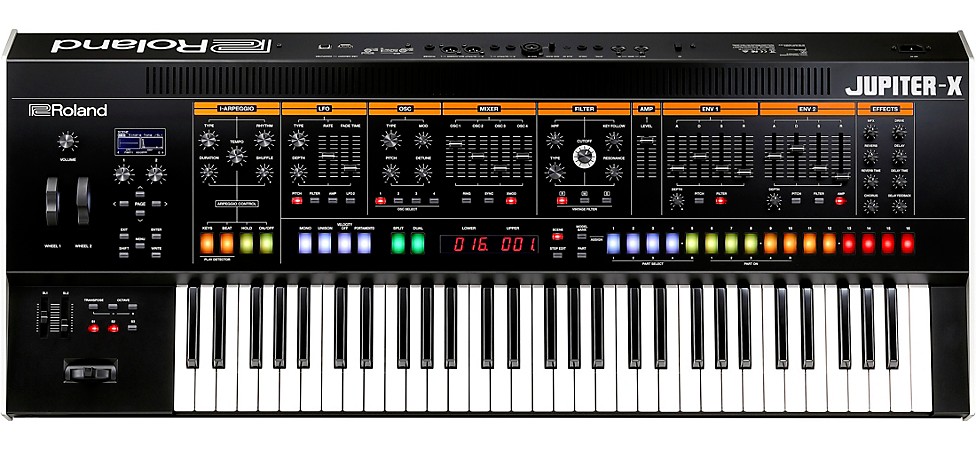
Pictured: Roland JUPITER-X Synthesizer
Another excellent digital choice is the KORG wavestate. Introduced at Winter NAMM 2020, KORG's wavestate builds on the wavetable/sample-based engine of the legendary KORG Wavestation from the early '90s, but with a lot of new features and some truly impressive possibilities for sound design and performance. Want to take things further? The KORG wavestate MKIl increases polyphony from 64 to 96 voices, adds 2GB of space for your samples, offers 15 new Performances and 43 new Programs, and updates all existing Performances and Programs. While we're talking KORG, if you are a fan of classic analog synths, but love the precision and control of digital synthesis, the KingKORG NEO, introduced at the 2024 NAMM show, is a compact synth with a vocoder mic featuring a virtual analog sound engine along with preset algorithms that make building new, stage-ready sounds fast and easy. Along with the latest iteration of the iconic microKORG, which has been the go-to for powerful vocoding and vocal synth effects from its first appearance, KORG stakes their space in portable, powerful, virtual analog systems with aplomb.
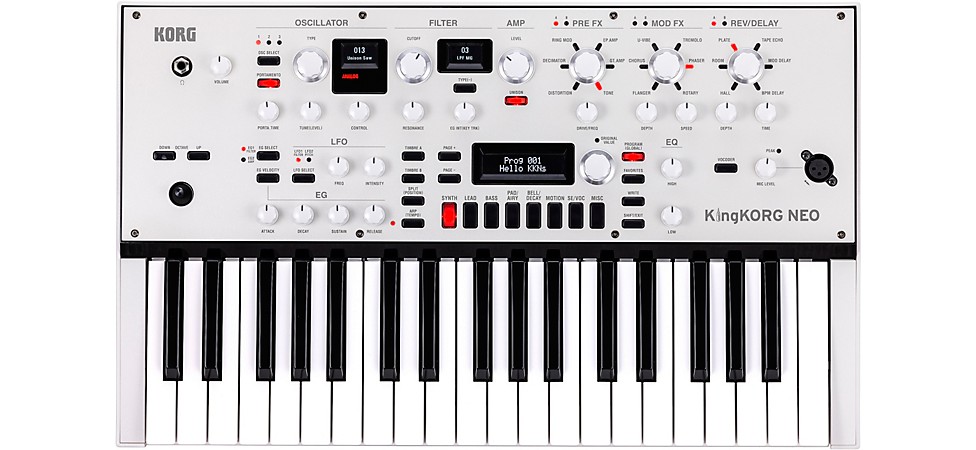
Pictured: KingKORG NEO VA Synthesizer
On the subject of portable and powerful, the Yamaha SEQTRAK delivers a versatile compact synth that's loaded with over 2,000 presets, dual synthesis engines (AWM2 and four-operator FM) and onboard sampling. With an interface that, as the manufacturer puts it, "enables you to create music and learn instead of reading a manual" (although reading the manual is always good), this app-connected system makes for a smooth workflow from original idea to finished creation. If, on the other hand, you're looking for a full-size workstation, the Yamaha MONTAGE M series (Montage M6, M7, M8x) offers a trio of digital tech to expand your synth colors—an AWM2 sample-based engine, an AN-X Virtual Analog engine and 8-operator FM-X synthesis.
The Arturia AstroLab provides studio production-based creators with a solution for bringing their heaviest sounds, textures and techniques to the live performance space—and all with an easy and intuitive interface that doesn’t impede inspiration or spontaneity. AstroLab features a 61-note, semi-weighted keyboard with aftertouch, more than 1,000 onboard sounds (10,000 with Arturia software), nine sound engines (virtual analog, physical modeling, FM, wavetable and more), four macro controls for rapid editing, 10 preset buttons for quick sound access, 17 effects and MIDI, Bluetooth and WiFi connectivity. You can also split the keyboard, and take advantage of arpeggiator, looper and chord and scale modes. And, of course, AstroLab’s aluminum and Bakelite housing is tough enough to take whatever punishment your gigs can dish out.
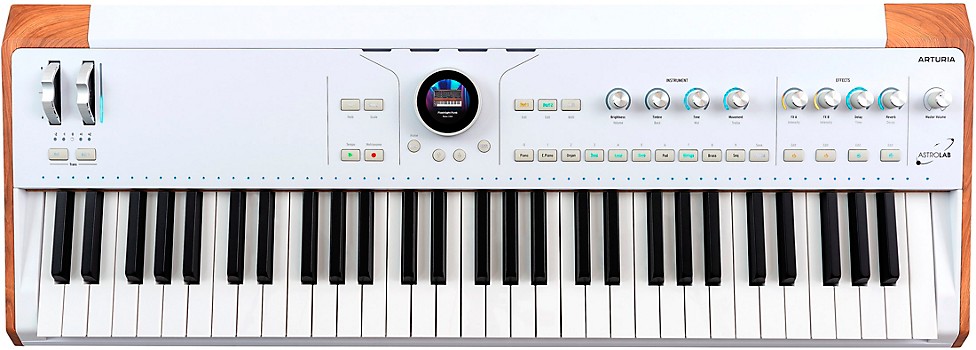
Pictured: Arturia AstroLab
Hybrid Synthesis
Hybrid synthesizers are a fairly new category, but a completely logical development. Taking the strengths of both analog and digital synthesis and combining them in new ways brings a whole new level of flexibility to the game. The stability of digital oscillators and wavetable/sample forms combined with fat, resonant analog filters and incredible flexibility in modulation sources can create sonic effects that weren't possible previously. The Sequential Prophet X, from legendary synth designer Dave Smith, combines sample-based synthesis with digital oscillators, analog filters and an extraordinary range of modulation possibilities for a mind-boggling range of sounds and effects. Roland's JD-Xa takes a different approach, with both Roland's renowned SuperNATURAL digital engine and a four-voice analog sound source. The system is loaded with all-analog filters and produces a sonic palette that combines the crispness and precision of digital with the rich warmth of the classic analog synths. Explore classic PPG-era wavetable synthesis with the Groove Synthesis 3rd Wave, which has a Dave Rossum-designed 2140 analog low-pass filter and utilizes 24-voice polyphony and four-part multi-timbral capability to serve up the power of four separate synthesizers. Not only that, the 3rd Wave’s built-in Wavemaker lets you craft up to 64 custom wavetables of your own.
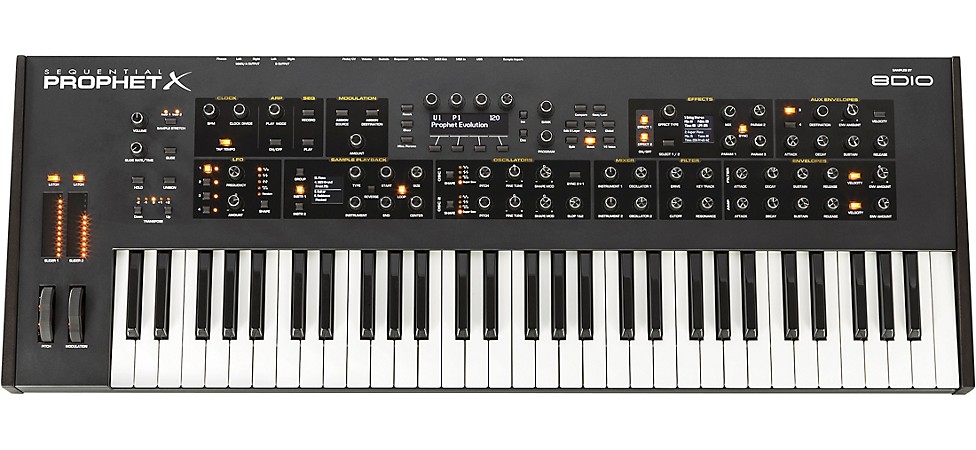
Pictured: Sequential Prophet X Synthesizer
Modeling Synthesis
A fairly recent development is the maturation of modeling synth. Like digital modeling of guitar amps, these synths use digital signal processing (DSP) chips to emulate the actions of traditional analog components. They can also model the behavior of traditional acoustic instruments, as with Roland’s COSM system. While the original research and concepts for physical modeling were in place in the early 1970s, usable systems had to wait for the development of sufficiently powerful DSP technology. Early synths that used modeling as part of their engine, like the Yamaha VL-1 and KORG Z1 first emerged in the 1990s. As more powerful DSP has come available, this technology has come of age. Several of the synths we mentioned here, like the Roland JD-Xi and the microKORG, use this technology as part of their synth engine. Another prime example is the Nord Lead A1 synth. Analog or physical modeling techniques are also a mainstay of many software synths, as discussed below.
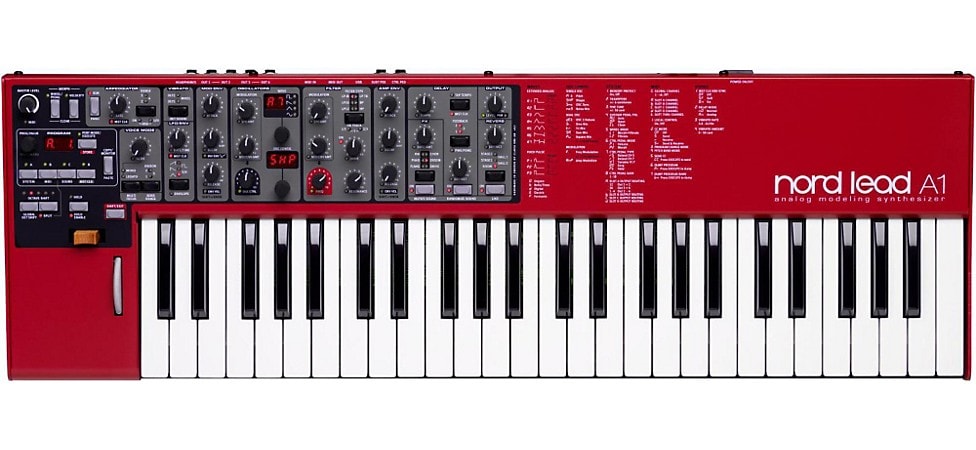
Pictured: Nord Lead A1 Analog Modeling Synthesizer
Synth or Workstation?
A frequently asked question is, "What makes a keyboard a workstation instead of just a synthesizer?" Even with the wide range of sound they can produce, a synth is a single instrument, whereas a workstation is more like a full studio.
Workstations generally have full-size keyboards with semi-weighted or hammer-action keyboards. Their capabilities include onboard sequencing and sampling capability. In addition to their on-board sample library, sample editing, and a powerful synth engine, some include the capacity for multi-track audio recording. Workstations like KORG's NAUTILUS or KROSS, the Roland's FANTOM and FANTOM-0 series or Yamaha's MONTAGE M Series and MODX+ are almost like full-blown production studios in a keyboard form factor.
A Quick Word About Software Synthesizers
If you're mostly working with a computer-based studio and long for a huge variety of synths to work with, we're going to insert a fast pointer here to the world of virtual synths. With virtual instrument collections, you can have all the vintage synths you've ever wanted, plus cutting-edge instruments. Arturia's V-Collection contains an ever-growing group of vintage synths and keyboards that are painstakingly modeled. Native Instruments' KOMPLETE production suites include another wide range of classic instruments.
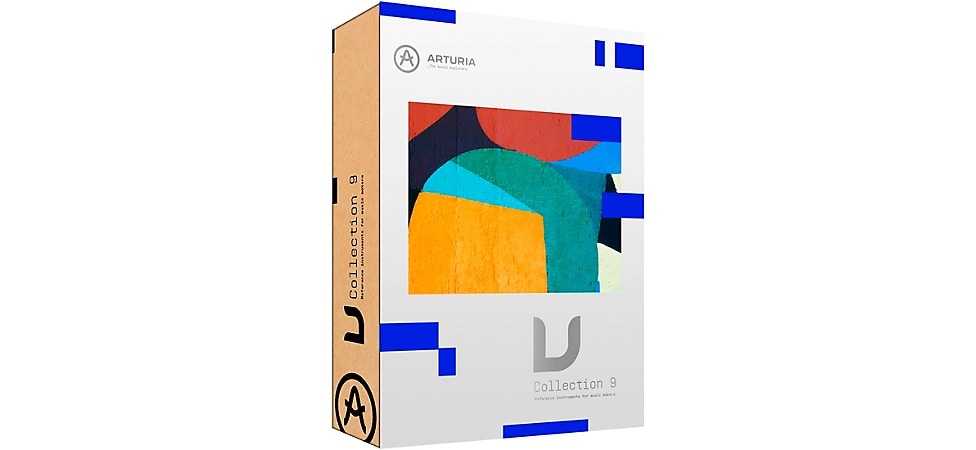
Pictured: Arturia V Collection 9 Software Instrument Bundle
Shopping for Synths
Buying and setting up your first synth can be confusing. Don’t be afraid to ask our Call Center or store associates for help. Even if you’ve spent lots of time researching, you’re not going to have all of the answers that experience can provide. Our associates can help answer your questions and explain key features and functions.
Auditioning Synths
If you’re shopping online, our Call Center associates can be a major asset in helping you zero in on exactly the right synth or workstation for the music you play. Of course, there’s no substitute for ears-on experience, but between our knowledgeable staff and generous 45-day return policy, you can be sure you’ll end up with a synthesizer you love.
Next time you walk into your Guitar Center store, head over to our keyboard section. You’ll find a wide range of synthesizers and workstations to check out, usually with headphones already connected. Sit down and get playing. Step through some presets and try them out with basic chords or any solos or riffs you feel comfortable playing. If you've been smart, you read a couple of manuals online beforehand, so try out some of the editing features and discover some new sounds. If you get a little lost, ask one of our associates for help and they can get you back on track and make some recommendations.
Getting Your Best Synth Deals
Be sure to ask if there are any promotions or sales currently running. Regardless, our 45-Day Low Price Guarantee ensures your best deal. At the time of purchase or any time within 45 days of your purchase, if you find the identical product advertised by any authorized dealer—including Guitar Center—at a lower price than what you paid, just show us the ad and your original receipt, and we’ll refund you 100% of the difference.

